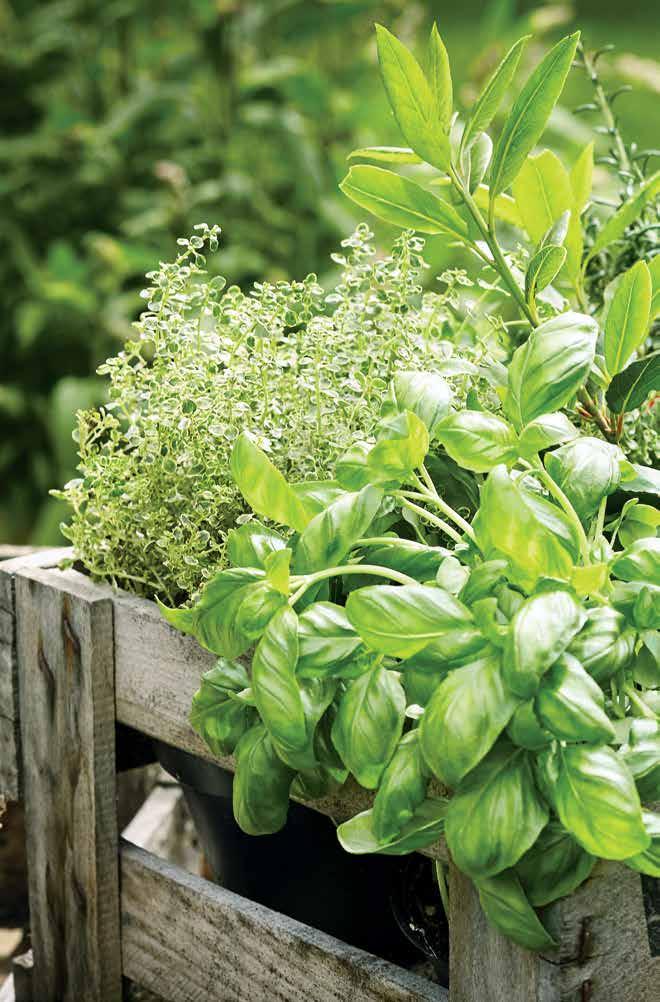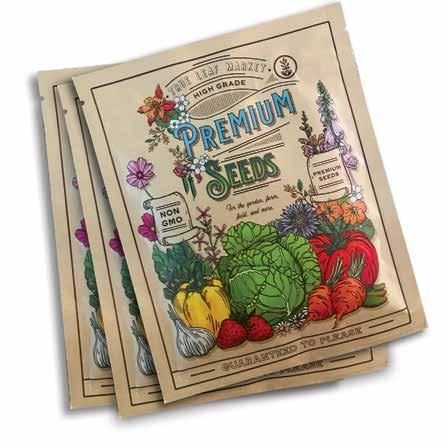
5 minute read
Thyme to Grow
One project that many people began at home in the past year was gardening. Having fresh veggies and herbs not only saves you a trip to the store, it supports healthy cooking and eating habits. Why buy processed, altered, or chemically treated when you can grow fresh? If you don’t have the space in your yard to plant vegetables and herbs, you can always grow a small container or window garden inside.
To start, you’ll need to find containers with a drainage hole at the bottom that are large enough to allow the roots of your plant to grow. Recycling plastic yogurt or deli containers works well if you add drainage holes. It’s also helpful to use gravel in the bottom for extra drainage. You’ll also want to make sure each container is placed on a tray, dish, or saucer to capture excess water so as not to ruin the surface or furniture on which they sit.

to GrowThyme


Use indoor potting soil to plant your veggies, herbs, or seeds, because it is specially formulated to help plants grow in indoor conditions. As much bright light as possible is a key to success growing vegetables and herbs inside, away from their natural environment. You want to reproduce outdoor light conditions as best as possible by using window light or spending some money on grow lights. Most vegetables need at least 4-6 hours of sunlight per day, while herbs need a minimum of 6 hours of sunlight and many varieties require 12 hours or more.
Low humidity can also take a toll on indoor plants, so mist them daily using a spray bottle to mist them with water each day or use a coolmist humidifier to keep the moisture in the air. But when it comes time to water, remember less is more. Keep the soil moist, in the sweet spot between dry and damp. Since the plants aren’t subjected to intense outdoor heat, they won’t dry out as frequently, so you’ll need to be careful not to overwater.
Veggies and herbs should sprout relatively quickly. However, it may take a few weeks or even months before you are able to harvest its yummy goodness. Summer is the best time of year to grow because that’s when the most natural light is available. But indoor vegetables and herbs can grow year-round and might help to brighten up the drearier months inside.

Herbs
The best place for a kitchen herb garden is on the sill of a south or southwest facing window, away from drafts, with a minimum of six hours of reliable sunlight. Mint, cilantro, chives, parsley, rosemary, dill, and some varieties of

Your Outdoor Lighting Specialists




oregano and thyme are all good herbs to grow indoors. Basil may need more sun than it can get in a window. In general, if an herb does well in partial shade outdoors, it will do well in a sunny indoor exposure. You’ll want to decide whether to start from seed or purchase small plants. Annual herbs are easy to start from seed, while perennial herbs germinate more slowly. Designate individual pots for each herb so each plant can be given the specific conditions it needs to flourish. Check seed packets to determine planting depth. If you want to a variety of herbs in a single container instead, make sure they all grow well in the same conditions. For example, sage and rosemary need cooler temperatures, while basil requires warmer temperatures. Fertilize herbs weekly with a weak liquid fertilizer for good growth, and remember to cut your herbs and use them! Cutting them back encourages new growth, but don’t harvest mote than 25% of the plant at one time
Green Stuff
Green onions and scallions grow well indoors because they’re easy to care for and don’t require as much sunlight as some other veggies. You can grow them from seeds or by simply replanting the root end of the green onions after using the top. Another reliable choice is leafy salad greens like spinach, kale, and arugula. They need about 12 hours/day of sunlight, thrive at around 60°F., and will grow in about four weeks in compact spaces.
Carrots and Radishes
Carrots and radishes are also good cooltolerant indoor veggies. While carrots need to be planted in deep soil, they don’t require much space around them, but radishes don’t like to be crowded. Carrots will need at least 12 hours a day of sunlight, and radishes need maybe half that. Radishes are quick growers, with only 30 to 40 days from germination to harvest.
Peppers and Tomatoes
Peppers and tomatoes are favorites for home gardens, but can they be grown indoors? Pepper plants are perennials that produce best in warm weather and full sun. But, as self-pollinating plants, they can still do quite well indoors if they get 14-20 hours of good light per day and the temperature is kept around 70°F. Plant them in an 8” or taller container and make sure to allow the soil to dry out between waterings. Tomato plants can do well in those same conditions, because they too are self-pollinating and love the light. To help with pollination, you can gently shake the plants. Smaller tomato varieties are better suited to container gardening and germinate relatively quickly from seeds.
Trending Now …
Art to Complement Your Home

Susan Anderson Tori Anderson Ella Cart Dottie Clark Suzanne Clements Roz Harrell Joan Hilliard Joyce Ledingham Trish Rugaber










